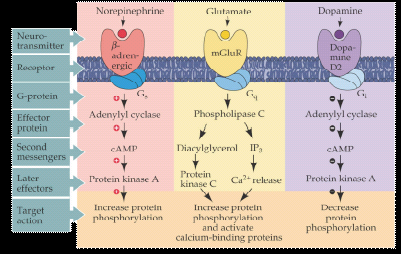|

The image above shows the specific pathways involved
in three different neuromodulators, each of which activates a
G-Protein Coupled Receptor (GPCR). Each of the
neuromodulators activates a G-Protein, which in turn activates
an effector protein, like Adenylyl cyclase in the case of
Dopamine. The effector protein is Kinase A for Dopamine, which
then results in a decrease of protein physphorylation for that
specific receptor. This change in protein phosphorylation directly
influences the membrane proteins and affects the
membrane potential and possibly the ultimate firing pattern of
the neuron, as is the case in the pyloric circuit of the
stomatogastric ganglion.
In the simulation of the pyloric circuit I
focus upon the effects of dopamine, but most importantly it is
crucial to recognize that it is the effector protein and NOT the
neuromodulator which affects the specific neuronal response.
This will be witnessed directly in the next section on the
Pyloric Circuit.
Specifically in the Pyloric Circuit,
experimentation has shown the following
|